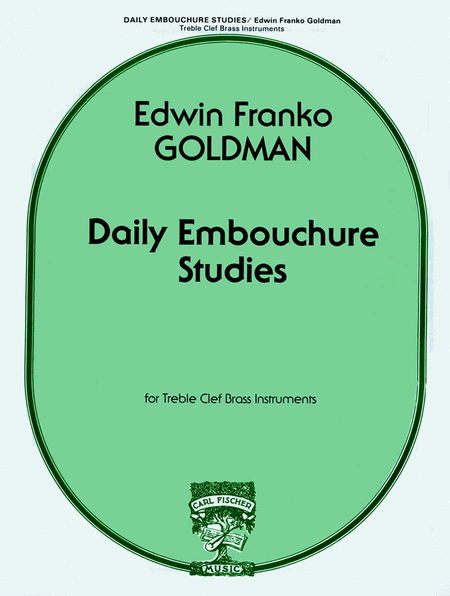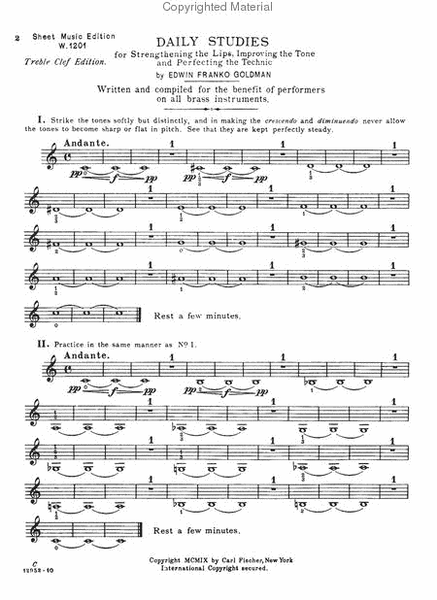Daily Embouchure Studies
For Treble Clef Brass Instruments
-
Ships in 1 to 2 weeks
Details
Description
SKU: CF.W1201
For Treble Clef Brass Instruments. Composed by Edwin Franko Goldman. This edition: New and Revised Edition. None. Softcover. With Standard notation. 12 pages. Carl Fischer Music #W1201. Published by Carl Fischer Music (CF.W1201).ISBN 9780825838941. UPC: 798408038946. 9 X 12 inches.
In presenting this little brochure to cornetists, trumpet players, and performers on all brass instruments, I had a three-fold purpose in mind: to provide study material for improving the tone, perfecting the technique and strengthening the lips and the muscles of the cheeks, the latter having so much to do with satisfactory performance. The exercises are not written with a view to being either tuneful or melodious; the are you exercises, pure and simple nothing more. They are not difficult, technically speaking, but if practiced regularly and conscientiously, the lips will be so strengthened that all the difficulties of the instrument may easily be overcome. The first and most important requisite to any one who plays a brass instrument is a strong lip or embouchure. Once that is acquired the rest is simply a matter of practice and perseverance. I have used these exercises daily for many years, and have personally found them to be very beneficial. They have also been of great value to my pupils, and have received the endorsement of many distinguished performers. The best time for the practice of them is in the early morning. If one has but little time to spend in practice, and will follow the suggestions herein laid down for that little time every day, the lips will at least be kept in good condition; and in a few weeks' time the result will be manifest in the much greater freedom and ease of performance, greater surety and flexibility of lip, and a surprisingly better quality of tone. These exercises are a daily necessity and after their mission has been accomplished, the most difficult solos can be mastered with ease. It requires only a short time to go through all the exercises, and if they are studied and performed according to directions they cannot fail to achieve the desired result, viz, a good and strong embouchure.
In presenting this little brochure to cornetists, trumpet players, and performers on all brass instruments, I had a three-fold purpose in mind: to provide study material for improving the tone, perfecting the technique and strengthening the lips and the muscles of the cheeks, the latter having so much to do with satisfactory performance. The exercises are not written with a view to being either tuneful or melodious; the are you exercises, pure and simple nothing more. They are not difficult, technically speaking, but if practiced regularly and conscientiously, the lips will be so strengthened that all the difficulties of the instrument may easily be overcome. The first and most important requisite to any one who plays a brass instrument is a strong lip or "embouchure". Once that is acquired the rest is simply a matter of practice and perseverance. I have used these exercises daily for many years, and have personally found them to be very beneficial. They have also been of great value to my pupils, and have received the endorsement of many distinguished performers. The best time for the practice of them is in the early morning. If one has but little time to spend in practice, and will follow the suggestions herein laid down for that little time every day, the lips will at least be kept in good condition; and in a few weeks' time the result will be manifest in the much greater freedom and ease of performance, greater surety and flexibility of lip, and a surprisingly better quality of tone. These exercises are a daily necessity and after their mission has been accomplished, the most difficult solos can be mastered with ease. It requires only a short time to go through all the exercises, and if they are studied and performed according to directions they cannot fail to achieve the desired result, viz, a good and strong embouchure.
In presenting this little brochure to cornetists, trumpet players, and performers on all brass instruments, I had a three-fold purpose in mind: to provide study material for improving the tone, perfecting the technique and strengthening the lips and the muscles of the cheeks, the latter having so much to do with satisfactory performance. The exercises are not written with a view to being either tuneful or melodious; the are you exercises, pure and simple nothing more. They are not difficult, technically speaking, but if practiced regularly and conscientiously, the lips will be so strengthened that all the difficulties of the instrument may easily be overcome. The first and most important requisite to any one who plays a brass instrument is a strong lip or "embouchure". Once that is acquired the rest is simply a matter of practice and perseverance.I have used these exercises daily for many years, and have personally found them to be very beneficial. They have also been of great value to my pupils, and have received the endorsement of many distinguished performers.The best time for the practice of them is in the early morning. If one has but little time to spend in practice, and will follow the suggestions herein laid down for that little time every day, the lips will at least be kept in good condition; and in a few weeks' time the result will be manifest in the much greater freedom and ease of performance, greater surety and flexibility of lip, and a surprisingly better quality of tone.These exercises are a daily necessity and after their mission has been accomplished, the most difficult solos can be mastered with ease. It requires only a short time to go through all the exercises, and if they are studied and performed according to directions they cannot fail to achieve the desired result, viz, a good and strong embouchure.
Song List (12)
- I
- II
- III
- IV
- V
- Vi
- VII
- VIII
- IX
- X
- XI
- XII


 Share
Share